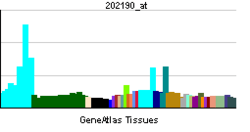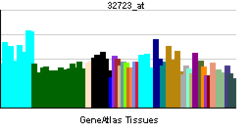CSTF1
| CSTF1 | |||||||||||||||||
|---|---|---|---|---|---|---|---|---|---|---|---|---|---|---|---|---|---|
| Identifiers | |||||||||||||||||
| Aliases | CSTF1, CstF-50, CstFp50, cleavage stimulation factor subunit 1 | ||||||||||||||||
| External IDs | MGI: 1914587 HomoloGene: 1012 GeneCards: CSTF1 | ||||||||||||||||
| |||||||||||||||||
| RNA expression pattern | |||||||||||||||||
  | |||||||||||||||||
| More reference expression data | |||||||||||||||||
| Orthologs | |||||||||||||||||
| Species | Human | Mouse | |||||||||||||||
| Entrez | |||||||||||||||||
| Ensembl | |||||||||||||||||
| UniProt | |||||||||||||||||
| RefSeq (mRNA) | |||||||||||||||||
| RefSeq (protein) | |||||||||||||||||
| Location (UCSC) | Chr 20: 56.39 – 56.41 Mb | Chr 2: 172.37 – 172.38 Mb | |||||||||||||||
| PubMed search | [1] | [2] | |||||||||||||||
| Wikidata | |||||||||||||||||
| View/Edit Human | View/Edit Mouse |
Cleavage stimulation factor 50 kDa subunit is a protein that in humans is encoded by the CSTF1 gene.[3][4][5]
This gene encodes one of three subunits which combine to form cleavage stimulation factor (CSTF). CSTF is involved in the polyadenylation and 3'end cleavage of pre-mRNAs. Similar to mammalian G protein beta subunits, this protein contains transducin-like repeats. Several transcript variants with different 5' UTR, but encoding the same protein, have been found for this gene.[5]
Interactions
CSTF1 has been shown to interact with BARD1.[4][6]
References
- ↑ "Human PubMed Reference:".
- ↑ "Mouse PubMed Reference:".
- ↑ Takagaki Y, Manley JL (Dec 1992). "A human polyadenylation factor is a G protein beta-subunit homologue". J Biol Chem. 267 (33): 23471–4. PMID 1358884.
- 1 2 Kleiman FE, Manley JL (Mar 2001). "The BARD1-CstF-50 interaction links mRNA 3' end formation to DNA damage and tumor suppression". Cell. 104 (5): 743–53. doi:10.1016/S0092-8674(01)00270-7. PMID 11257228.
- 1 2 "Entrez Gene: CSTF1 cleavage stimulation factor, 3' pre-RNA, subunit 1, 50kDa".
- ↑ Kleiman, F E; Manley J L (Sep 1999). "Functional interaction of BRCA1-associated BARD1 with polyadenylation factor CstF-50". Science. UNITED STATES. 285 (5433): 1576–9. doi:10.1126/science.285.5433.1576. ISSN 0036-8075. PMID 10477523.
Further reading
- Takagaki Y, MacDonald CC, Shenk T, Manley JL (1992). "The human 64-kDa polyadenylylation factor contains a ribonucleoprotein-type RNA binding domain and unusual auxiliary motifs". Proc. Natl. Acad. Sci. U.S.A. 89 (4): 1403–7. doi:10.1073/pnas.89.4.1403. PMC 48459
 . PMID 1741396.
. PMID 1741396. - Murthy KG, Manley JL (1995). "The 160-kD subunit of human cleavage-polyadenylation specificity factor coordinates pre-mRNA 3'-end formation". Genes Dev. 9 (21): 2672–83. doi:10.1101/gad.9.21.2672. PMID 7590244.
- Takagaki Y, Manley JL (1994). "A polyadenylation factor subunit is the human homologue of the Drosophila suppressor of forked protein". Nature. 372 (6505): 471–4. doi:10.1038/372471a0. PMID 7984242.
- Rüegsegger U, Beyer K, Keller W (1996). "Purification and characterization of human cleavage factor Im involved in the 3' end processing of messenger RNA precursors". J. Biol. Chem. 271 (11): 6107–13. doi:10.1074/jbc.271.11.6107. PMID 8626397.
- Kleiman FE, Manley JL (1999). "Functional interaction of BRCA1-associated BARD1 with polyadenylation factor CstF-50". Science. 285 (5433): 1576–9. doi:10.1126/science.285.5433.1576. PMID 10477523.
- Takagaki Y, Manley JL (2000). "Complex Protein Interactions within the Human Polyadenylation Machinery Identify a Novel Component". Mol. Cell. Biol. 20 (5): 1515–25. doi:10.1128/MCB.20.5.1515-1525.2000. PMC 85326
 . PMID 10669729.
. PMID 10669729. - Fong N, Bentley DL (2001). "Capping, splicing, and 3′ processing are independently stimulated by RNA polymerase II: different functions for different segments of the CTD". Genes Dev. 15 (14): 1783–95. doi:10.1101/gad.889101. PMC 312735
 . PMID 11459828.
. PMID 11459828. - Deloukas P, Matthews LH, Ashurst J, et al. (2002). "The DNA sequence and comparative analysis of human chromosome 20". Nature. 414 (6866): 865–71. doi:10.1038/414865a. PMID 11780052.
- Andersen JS, Lyon CE, Fox AH, et al. (2002). "Directed proteomic analysis of the human nucleolus". Curr. Biol. 12 (1): 1–11. doi:10.1016/S0960-9822(01)00650-9. PMID 11790298.
- Strausberg RL, Feingold EA, Grouse LH, et al. (2003). "Generation and initial analysis of more than 15,000 full-length human and mouse cDNA sequences". Proc. Natl. Acad. Sci. U.S.A. 99 (26): 16899–903. doi:10.1073/pnas.242603899. PMC 139241
 . PMID 12477932.
. PMID 12477932. - Gerhard DS, Wagner L, Feingold EA, et al. (2004). "The Status, Quality, and Expansion of the NIH Full-Length cDNA Project: The Mammalian Gene Collection (MGC)". Genome Res. 14 (10B): 2121–7. doi:10.1101/gr.2596504. PMC 528928
 . PMID 15489334.
. PMID 15489334. - Rush J, Moritz A, Lee KA, et al. (2005). "Immunoaffinity profiling of tyrosine phosphorylation in cancer cells". Nat. Biotechnol. 23 (1): 94–101. doi:10.1038/nbt1046. PMID 15592455.
- Tsuzuki M, Wu W, Nishikawa H, et al. (2006). "A truncated splice variant of human BARD1 that lacks the RING finger and ankyrin repeats". Cancer Lett. 233 (1): 108–16. doi:10.1016/j.canlet.2005.03.012. PMID 15878232.
This article is issued from Wikipedia - version of the 6/6/2016. The text is available under the Creative Commons Attribution/Share Alike but additional terms may apply for the media files.